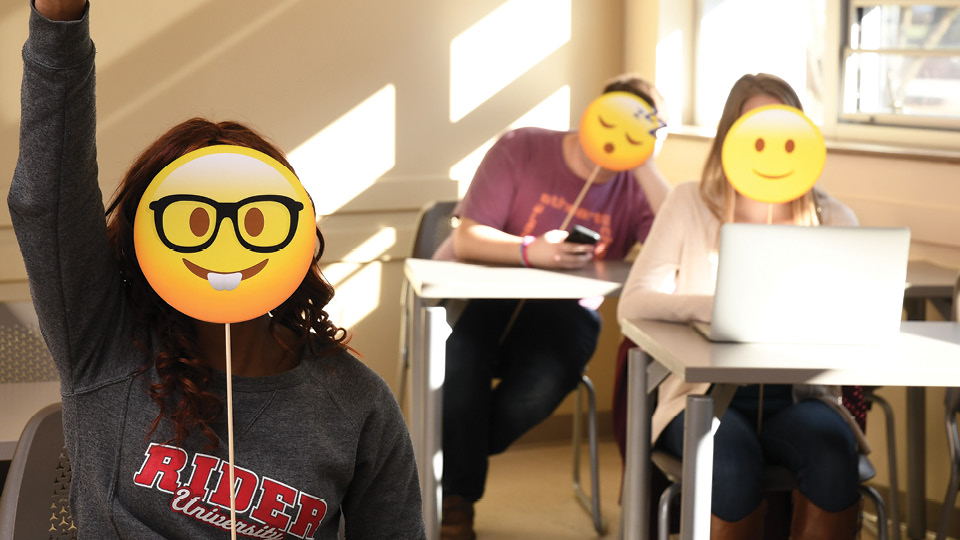by Adam Grybowski
In the mid-1990s, a new game called “The Palace” was released on the internet. A forerunner to virtual worlds like “The Sims” and “Second Life,” it invited users to create avatars and navigate an imaginary mansion and interact with each other through on-screen, cartoon-like speech bubbles. Crude by today’s standards, the interface and graphical imagery of “The Palace” were novel and even sophisticated for those accustomed to text-only chat rooms.
Upon its release, a psychology professor with a strong interest in imagery and visual design named Dr. John Suler downloaded the program and began tinkering with it. “I was fascinated,” he recalls. “It was pitched as a game but the players spent their time socializing. And because people had to create an identity for the game, it was a social world with imaginary representations of themselves. Over time, the community got bigger and bigger. People were misbehaving. They needed rules and they needed people to enforce the rules.”
In other words, the new digital world looked a lot like its non-digital counterpart. But this unique form of mass media differed in a fundamental way from what came before it. Unlike radio and television, the internet provided a platform for immersive social interaction — with no geographical constraints. It was a virtual environment that allowed people to form new relationships and create new identities. It was social and it was psychological.
“I saw ‘The Palace’ environment like a dream world, and people were so into it that they became addicted to it,” Suler says. “I started writing about it in a serious way. A lot of the issues have since blown up to 10 times their original size.”
Suler, who has been a member of Rider University’s Department of Psychology since 1982, recognized “The Palace” as a fertile research subject. He immersed himself in study, and even while he felt his work was yielding new insights, he knew of no one else studying cyberspace (though a bit dusty, “cyberspace” remains Suler’s preferred term for the digital world). However, clinicians and others with a serious interest in the phenomenon gradually awoke to their growing network. Some found each other after Suler published, in 1996, the first version of his online book, The Psychology of Cyberspace. The book — the first ever written about cyberpsychology — examined how people behave online and addressed topics like personal identity and interpersonal relationships in the context of the internet.
The Psychology of Cyberspace helped establish Suler as one of the world’s leading experts in the new field, the “father of cyberpsychology.” Suler was also among the first to perceive the possibility that the internet, and related technologies like email and chat, could be used to address mental health issues through education, intervention and therapy. It was also evident that, even at its nascent stage, the internet could actually accelerate some mental health issues, as well as create new categories of psychological disorders, such as internet addiction and mobile phone separation anxiety.
Suler’s major contribution has been to translate conventional psychological terms into describing how people behave online. He is most well-known for his insight into what’s called the “online disinhibition effect.” Anyone who has spent time in the comments section of almost any website knows that people tend to behave in ways online that they would not normally, or ever, behave offline. Such disinhibited acts can take several forms, from sharing very personal information to making outsized threats. According to Suler, several forces combine to cause disinhibition — anonymity and the false perception of privacy among them. Some online behavior, like disinhibition, overlaps with the way people act in the real world. Other types of online behavior diverge in illuminating ways. For decades, psychologists have used a concept called introjection to describe the process of incorporating the characteristics of another person into one’s own psyche. Online, this process plays out absent face-to-face interaction. In his 2016 book, The Psychology of the Digital Age, Suler writes, “The online companion now becomes a constructed character within our intrapsychic world, a character that is shaped partly by how the person actually presents him or herself via text, but also by our expectations, wishes and needs.”
Once confined to our imaginations, these internal conversations now play out on millions of computers connected around the world. Because of that, Suler compares the internet to a “giant projection of the human psyche.” He notes that these projections can be either benign or toxic, and that while altruism is not uncommon on the web, rudeness, harsh criticism and boiling hatred are often more salient.
“I think we live in a time when people are angry and frustrated and disappointed, and because of that inner turmoil, they have to do something with it,” Suler says. “The internet becomes an easy place to express those feelings, but using technology like that can damage a person’s growth if it never leads to a greater understanding of themselves. Temper tantrums don’t help children grow.”
Suler grew up in mid-century Long Island among the potato fields that preceded widespread suburban development. His father, John, flew in the Air Force during World War II and was transferred to the Army during the Battle of the Bulge. After returning home, he met a woman named Doris in New York City. The two married, moved to Long Island and had four children. Suler recalls ample time as a child to indulge his interests in toy soldiers, science fiction and photography. Oriented toward science and math in school, he believed he would pursue a career in engineering.
At the urging of his parents, he also hoped to enroll in the Air Force Academy, but while still in high school, Suler switched gears. He had become fascinated by Freudian theory in a psychology class. “Here was a model of how people think,” he says, “a whole discipline focused on what’s happening inside people’s mind.” When the time came to tell his parents about his newfound interest, and his desire to pursue psychology instead of engineering, he says “their eyes started spinning in their heads. They had no idea what psychology was.”
After high school, he matriculated as an undergraduate at Stony Brook University in New York. Put off by the program’s emphasis on the behavioral psychology of Pavlov and Skinner, he supplemented his studies with courses in religion and philosophy. “I’ve always been introspective and intuitive and curious about what’s going on in people’s heads, and I wanted to learn about the interior world,” he says.
He graduated summa cum laude in 1977 and then continued his education as a graduate student at State University of New York at Buffalo. Mirroring his experience as an undergraduate, Suler found that the aim of his graduate program didn’t exactly match his aspirations. “They were training you to be a scientist, but I still wanted to know more about psychotherapy,” he says. He pursued his interests — persisting as “a bit of an oddball” and setting a career-long pattern of applying himself to topics outside the lines of conventional psychology. Suler received a doctorate in clinical psychology in 1982 and, the same year, joined the faculty of Rider University, where he has spent his entire career.
More than 20 years after the publication of The Psychology of Cyberspace, Suler’s landmark book, the distinction between lives lived online and off continues to collapse, with real consequences. Smartphone use has been attributed to skyrocketing teen depression and suicide rates. Social media has proven to divide as much as connect, with tribes of all stripes hunkering down into hand-curated echo chambers that reinforce existing beliefs at the expense of new ideas.
Surveying our current relationship to technology, Suler says, “I used to think it would all turn out fine. Now I’m not so sure.”
In the classroom, Suler’s primary goal is to help his students better understand themselves. He teaches several courses. For many years he has used his unconventional first book, a novel called Madman: Strange Adventures of a Psychology Intern, as a textbook to teach abnormal psychology. (The story is loosely based on Suler’s real experiences as an intern in the psychiatric unit of a modern teaching hospital.) An accomplished photographer who has exhibited his photographs in Rider’s art gallery, Suler will use his latest book, Perception and Imaging: Photography as a Way of Seeing (written with Richard D. Zakia), for a class on psychology and photography in the fall.
Last spring, while teaching a class on cyberpsychology, he asked his students to put down their phones, step outside and take a short walk around campus. Separated from their phones, some students reported feelings of anxiety, others a sense of relief. Some described feeling a sense of vulnerability, like they were naked in the world. “In this age we live in, we have a symbiotic relationship with technology,” Suler says. “I had to remind the students that there was a time when we didn’t have cell phones.”
Once students leave the classroom, Suler notes that they have a lot working against them, in terms of freeing themselves from digital distraction. “Tech companies have teams of really smart people working to make their products addictive,” Suler says. “A lot of horrible stuff happens because of that, but only if we choose to keep coming back to it.”
He recognizes a deep need to educate people about how to use their devices in ways that benefit their health, or at least in ways that don’t detract from it. In his own life, Suler continues to log on for personal and professional reasons, but more and more he feels the growing weight of our digital lives — the compounding abundance of information, the facts and alternative facts, the memes and tweets. He also senses the dangers beyond personal well-being. While ticking off some of technology’s threats, including the invasions of privacy, the absence of security and the outright manipulation of reality, Suler grimaces.
“It’s too much,” he says.
The professor who has described online behavior with unparalleled insight adds: “It’s all getting a little scary.”




